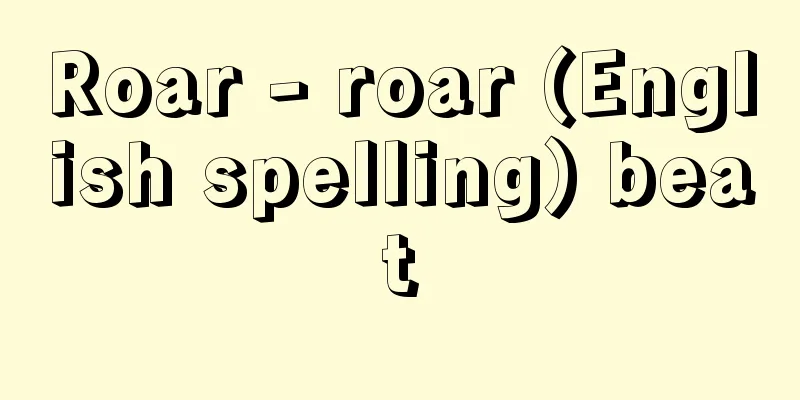Bow - Yumi

|
A type of weapon that uses the elasticity of a string stretched over elastic wood or bamboo to fire an arrow. The origin of the Japanese bow is unclear, but it is known that it existed at least before the Jomon period. Based on their shape and structure, bows can be classified into single-material bows, composite bows, long bows, short bows, straight bows, curved bows, wide handles, and narrow handles. Jomon bows excavated in Japan are all around 1.2 to 1.6 meters long, while those from the Yayoi period are around 2.0 to 2.3 meters long, showing a trend toward longer bows as the period progresses. The bows used at that time were straight round log bows carved from single pieces of wood such as inugaya, inumaki, and mulberry. These bows include those made of plain wood and those wrapped in bark and then painted with vermilion or black lacquer; Yayoi period bows also have a groove on the belly side (inside) to adjust the deflection and prevent breakage, and the shapes of the bows also vary. During the Kofun period, bows thought to have been used by ceremonial guards were discovered, with the bows decorated with metals such as copper, gold, and silver. There are currently 27 bows preserved in the Shosoin Repository, and looking at them, they are made of azusa and zelkova wood and vary in length, with the most common being around 7 shaku 2 sun (2.18 meters). Considering that the modern Japanese bow is 7 shaku 3 sun (2.21 meters), it can be said that from this time onwards, Japanese bows showed a trend towards long bows and became established. Around the middle of the Heian period, the "Fuse-dake-yumi" (hide bamboo bow) was invented, a semi-curved bow made of wood and bamboo with bamboo attached to the outside of the previous round wooden cut bow. It is also called the "Mamaki-yumi". Nibe (high-quality glue) was used to glue the wood and bamboo together, but it was not used much for military purposes as it was vulnerable to rain and dew. Furthermore, from the end of the Heian period to the beginning of the Kamakura period, the "Sanmaiuchi (bow)" was created, with bamboo attached to the bottom of the bow as well. During the Muromachi period, the "Shihodake (bow)" was invented, with bamboo attached to both sides of the bow and a wooden core, and before the Edo period, the "Higoiri (bow with bamboo strips)" was invented, with 3 to 5 strips threaded through the core, with bamboo sandwiched inside and out and wooden (haze) sides. A bow with a unique shape (sei = curve) was invented to exert a strong repulsive force. This structure has been followed ever since to this day. Japanese bows are made by skillfully combining wood and bamboo, which are relatively easy to obtain, with the grip located two-thirds of the length of the bow, making them less likely to break, and are also designed with great repulsive power, making their structure so rational that there is no room for improvement from a mechanical standpoint.Their shape features beautiful curves that are not seen in bows from other countries. There are various types of Japanese bows depending on their purpose. First, there are large bows over 2 meters long that are mainly used for practical purposes, such as target bows, finger and arrow bows, and military bows. There are lacquered bows (bodies completely lacquered, or bows with only the sides lacquered, such as sobaguro and sobaaka), which were used as exteriors to protect against damage (especially from rain and dew) and later also for decoration, and cane-wrapped bows, which developed from bows wrapped in bark in primitive times to strengthen them. This rattan-wrapped bow is called a shigedo-yumi (heavy rattan bow) because the rattan is wrapped thickly around it, and there are more than twenty types of shigedo-yumi, such as "moto shigedo", "futadokoro shigedo", "mitokoro shigedo", and "fushigome shigedo", depending on the wrapping style, position, width, and spacing. Shigedo-yumi were used extensively in actual battles from the mid-Heian period, but became a symbol of the general from the Muromachi period onwards. There are also beautifully decorated bows for ceremonial use, with ikakeji (gold-painted) makie (lacquer work) and black lacquer makie (lacquer work). Other types of half bows include the palanquin half bow, made from whale baleen and used to defend against enemies from inside a palanquin, the pillow half bow, kept at the pillow, and the portable travel half bow, which can be folded in half. Bows have also been called suzumekoyumi, yangyu, hamayumi, and other names since ancient times, and were used as toys by nobles, samurai, and private citizens alike. These are small bows measuring around 3 shaku in length. A bow only functions when a string is strung on the stem. In ancient times, it is thought that ivy or similar natural vines were used for strings. A fragment of the oldest surviving string is preserved in the Shosoin Treasures. This was made of hemp with a single twist, and since then, no other material has been used for stringing than hemp (nowadays, there are strings made of synthetic fibers). The order in which a string is made is to twist spun hemp, insert it, soak it in water, stretch it on a round bamboo to drain the water, and then thoroughly apply a medicinal paste and dry it. This is called a white string. In military camps, painted strings (lacquered) were used to protect against rain and dew. The rings made to attach the string to the upper and lower bowstrings are called the upper and lower hooks. In addition, a middle hook (nakajikake) is made to stabilize the nock at the place where the arrow is attached and to reinforce the string. In addition, on military battlefields, a small bump is made on the top of the inner mechanism so that the arrow is always nocked in the same position. This is called a "tsuyu" (search). Until the introduction of firearms, bows occupied a central position as weapons, and because of their power they have long been linked to faith as sacred objects and gods, remaining deeply integrated into Japanese life to this day. [Kohei Irie] Bows from around the worldThe bow and arrow, whose history dates back to the late Paleolithic period, was a revolutionary invention as a way to concentrate energy. The accuracy of the arrow was higher than that of a javelin, and because arrows were light and easy to carry, they became popular during the Mesolithic period, when small animals became the main prey. Bows are a projectile weapon widely distributed around the world, but there are also ethnic groups that do not have them at all, such as the Australian Aborigines and the former Tasmanian natives. They can be divided into long and short bows according to their length, and can also be divided into simple bows, compound bows, and combination bows according to their structure. Simple bows are made of a single elastic element of wood, such as palm, bamboo, or yew, or horn or antler. The end of the bow is thin, and a hole is drilled or notched into it to hold the string. The string is made of leather, hair, tendon, rattan, or wood fiber. The length depends largely on the correlation between the material and the tension, and can range from less than one meter, such as the bows of the San people of Africa, to over two meters, such as those of the Semang people of the Malay Peninsula and the Andaman Islanders. They are found in Asia, such as the Philippines, Assam, and Myanmar, as well as Oceania, North and South America, and Africa. Composite bows are made from several short pieces of wood joined together, and are thought to have been invented to overcome material limitations in tree-poor areas where bowmakers had to rely on driftwood, horns, and antlers. A composite bow is a simple bow that is made stronger by wrapping it with string or lining it with tendons. The composite bow is known from Southwestern, Central and Northern Asia, the Northwestern coast of North America and Southeast Europe. Animal tendons are stretched or tied to the convex outer surface of the bow body, which gives the bow enough resistance to bend backwards when the string is loosened. The bows of Siberian nomads and hunters are extremely complex, and are not only lined with tendons but also have pieces of horn attached to the concave inner surface of the bow body. There are also cases where a single bow is both a composite bow and a composite bow, such as the tendon-stretched bows of the Inuit and some Native Americans of the American Plains. Persia and Turkey also created bows that were strong and elastic but light by gluing together multiple thin panels of wood, horn, tendons and bone. It is fair to say that the Turkish horseback bow in particular was the driving force behind Turkey's great military success in the late Middle Ages. Bows have been treated with care as tools that can affect the outcome of battles and hunting. In Mongolia, when a bow is first used, words of praise are offered and offerings are made to it, and when the owner dies, it is even placed next to the right hand and buried in the grave. The indigenous Desana people of the Amazon consider the bow to be a symbol of masculinity, and forbid women and men whose wives are pregnant or menstruating to touch it, because they believe it will bring bad luck in hunting. However, with the invention and spread of firearms, bows and arrows have lost their status as hunting and military equipment, and are gradually disappearing. [Yuji Seki] History of Bow TechnologyThe principle of the bow seems very simple to modern people. Perhaps because of this, people tend to think that the bow was invented at a fairly ancient time, but in fact this is not the case. There is no evidence that Cro-Magnons used bows, and it is unlikely that such evidence will ever be found. This is because there is indirect evidence that suggests they did not use bows. This evidence is a projectile called a javelin, which is more difficult to handle than a bow. It is a stick about several tens of centimeters long with a hook attached. The spear is thrown by pushing the butt of the spear with the hook and swinging the stick. It requires rigorous training to hit the target with a javelin, and it does not hit the target as well as a bow, so it is by no means a convenient tool, but they used it. Incidentally, it is believed that ancient humans who traveled to the Australian continent before the invention of the bow took their javelins and boomerangs with them. They developed these tools there, but continued to live as a minority group without any contact with cultures that had bows. The Australian aborigines did not own bows, and instead hunted fish and birds with javelins and boomerangs. This example shows that bows were not yet in widespread use when humans traveled to Australia. Also, when looking at murals of ancient people that remain around the world, bows first appear in paintings from about 10,000 years ago or later. If you break down a bow, it consists of a flexible shaft and a strong string. The shaft is made of wood or bamboo, but humans probably became aware of the elasticity of wood and bamboo at a much earlier time. It is also believed that humans have had a very long relationship with strings. In the history of mankind, it is only quite recently that humans combined these two things that they had known for a long time to invent a single tool, the bow. It seems that it was surprisingly difficult for ancient people to create a new tool by combining tools that they already knew well. However, once the bow was invented, it quickly spread. In the areas where the bow was introduced, less convenient tools such as javelins and boomerangs were discarded and lost from people's memories. In the case of Australia mentioned above, the last ice age on Earth ended around the time the bow was invented and began to spread, and the Australian continent became isolated by the sea, so it is assumed that people with bows did not have the opportunity to travel there after that. Once the bow was invented and spread, it began to be used for purposes other than its original purpose. One typical example is musical instruments. The pleasant sound produced by plucking a bowstring is thought to have been the origin of stringed instruments. At first, bows were used as instruments as they were, and the pitch of the sound was thought to be produced by changing the pressure on the string (this is how the San, a hunter-gatherer people of Africa, did it). Later, the shaft of the bow was replaced with a thicker body, the number of strings was increased, and the body was made hollow to create an echo of the sound. Some instruments have a larger body, like the koto and harp, while others have a developed body that retains part of the shaft, like the shamisen, biwa, violin, mandolin, and guitar. If the body of the violin with its four strings is itself the bow, then the strings would be rubbed against the strings of another bow, and it is thought that the original form of the violin was produced by rubbing the strings of two bows together to produce sound. Bows were also used to make awls. This is called a "yumikiri." The bowstring is wound around the handle of the awl, and the bow is moved back and forth to rotate the awl. It seems that shipwrights on large ships often used this tool, as it provides a stronger force than rotating the handle by hand. The awl was also used as a fire starter to make fire. [Masao Iwaki] [Reference] | | |©Katsuya Nishikawa "> Names of each part of the bow (heavy rattan bow) Source: Shogakukan Encyclopedia Nipponica About Encyclopedia Nipponica Information | Legend |
|
弾力性のある木・竹などに弦(つる)を張り、その弾力を利用してつがえられている矢を飛ばす武器の一種。日本の弓の起源についてははっきりしたことはわからないが、少なくとも縄文時代以前にはすでにあったことが知られている。弓はその形状、構造から単材弓・合成弓、長弓・短弓、直弓・彎弓(わんきゅう)、広把(こうは)・狭把(きょうは)などに分類することができる。日本で発掘される縄文時代の弓はいずれも1.2~1.6メートルくらい、また弥生(やよい)時代のものは2.0~2.3メートルくらいのものであり、時代が下るにしたがい長弓の傾向を示す。このころの弓材はイヌガヤ、イヌマキ、クワなどの単材を削った丸木弓の直弓である。これらの弓には白木のままのものと、樹皮を巻きその上を朱または黒漆塗りのものがあり、弥生時代の弓はこれに加うるに腹側(内側)に樋(ひ)を通し、たわみを調整し、破損防止のくふうが施されており、弭(ゆはず)の形もさまざまである。 古墳時代になると、弭に銅、金、銀など金属をつけた儀仗(ぎじょう)用と思われる弓が発見されている。正倉院には現在27張りの弓が保存されているが、それらをみると材質はアズサ、ケヤキ材で長さはさまざまであるが、7尺2寸(2.18メートル)くらいのものがもっとも多い。現代の日本弓が7尺3寸(2.21メートル)であることを考えれば、このころより日本の弓は長弓の傾向を示し定着したといえる。 平安時代中期ごろになり、それまでの丸木削弓の外側に竹を張り付けた半彎弓で木竹合成の「伏竹弓(ふせだけゆみ)」が考案された。「継木弓(ままきゆみ)」ともいう。木・竹の接着剤として鰾(にべ)(上質の膠(にかわ))が用いられたが、雨露に弱く軍用にはあまり用いられなかった。さらに平安時代末期から鎌倉時代初期にかけて、弓の腹側にも竹を張り付けた「三枚打(弓)」がつくられた。 室町時代になると、弓の両側面にも竹を張り付け、木を芯(しん)とした「四方竹(弓)」が発明され、江戸時代に入る以前までに、芯に3~5枚のひごを通し、内・外を竹で挟み両側面を木(櫨(はぜ))とした「ひご入り弓」が考え出され、強力な反発力を発揮させるために、独特の形(なり)(勢=曲線)をもつ弓が考え出された。この構造は以後今日に至るまで踏襲されている。 日本の弓は、比較的入手容易な木と竹をうまく組み合わせ、握り部を全長の3分の2下に置き破損しにくく、しかも強い反発力をもたせるようくふうが凝らされ、力学的にみても改良の余地のないほど合理的な構造となっている。その形は諸外国のものにみられない美しい曲線を描いている。 日本の弓の種類は、その使用目的によりさまざまある。まず、およそ2メートル以上の実用を主とする大弓には、的弓(まとゆみ)、指矢弓(さしやゆみ)、軍弓などがある。外装として破損防止(とくに雨露に対し)を目的とし、のちには装飾をも兼ねた漆塗り弓(全面漆塗りとした弓や、側面だけ塗った弓=側黒(そばぐろ)・側赤(そばあか)など)、原始時代樹皮を巻き強化したことから発展した籐巻きの弓(とうまきのゆみ)がある。この籐巻きの弓は籐を重(しげ)く巻くの意から重籐弓(しげどうゆみ)とよばれ、その巻き様、位置、幅、間隔などの相違により「本(もと)重籐」「二所(ふたところ)重籐」「三所(みところ)重籐」「節籠(ふしごめ)重籐」など二十数種類もの重籐弓がある。重籐弓は平安時代中期ごろから盛んに実戦に用いられたが、室町時代以降は大将の象徴となった。また儀仗用としては沃懸地(いかけじ)(金泥(きんでい)塗り)蒔絵(まきえ)や黒漆塗り蒔絵を施した美しい装飾弓もある。 そのほか半弓の類として、クジラのひげ材でつくり、駕籠(かご)の中から敵を防ぎ射る駕籠半弓や枕元(まくらもと)に備える枕半弓、二つ折りにできる携帯用の旅半弓などがある。また弓は古くから雀小弓(すずめこゆみ)、楊弓(ようきゅう)、破魔弓(はまゆみ)などと称し、玩具(がんぐ)として公家(くげ)、武家、民間を問わず用いられた。これらは3尺内外の小弓である。 弓は弓幹(きゅうかん)に弦を張って初めてその機能を発揮する。弦は古くはツタやその類の自然のつるが用いられたと考えられる。現存する最古の弦としては正倉院宝物にその断片が残されている。これは麻を片捻(かたひね)りにしたもので、以後今日まで弦材として麻以外に求めたことはない(現今では合成繊維の弦がある)。弦の製作順序は、紡いだ麻を縒(よ)り、差し、水に浸したのち丸竹に張り水抜きをし、さらに薬練(くすね)を十分に塗り込み乾燥させるのである。これを白弦(しらづる)という。軍陣などでは雨露を防ぐため塗り弦(漆塗り)が用いられた。弦を上下の弭にかけるためにつくる輪を上関(うわぜき)・下関(したぜき)という。さらに矢をつがえる場所に筈(はず)の安定を図り、弦を補強するため中仕掛(なかじかけ)(中関)をつくる。なお軍陣では、いつも一定の位置に矢がつがえられるよう、中仕掛の上部に小さなこぶ状のものをつくる。これを露(つゆ)(探り)とよぶ。 弓は鉄砲が伝来するまで武器の中心的位置を占め、その威力から神器・聖器として古くから信仰と結び付き、今日に至るまで日本人の生活に深く溶け込んでいる。 [入江康平] 世界各地の弓弓矢は後期旧石器時代にさかのぼる歴史をもつが、エネルギーを集中する方法として画期的な発明であった。命中率も投げ槍(やり)より高くなり、また矢は軽く、携行にも便利であるため、小形動物がおもな獲物の対象となった中石器時代に飛躍的に広まった。 弓は広く世界に分布している飛び道具だが、オーストラリア・アボリジニーやかつてのタスマニア先住民のようにこれをまったくもたない民族もある。長さによって長弓と短弓の別があり、また構造によって単弓、複合弓と組合せ弓に区別することもできる。単弓はヤシ、タケ、イチイなどの木か、角(つの)かまたは枝角の弾力性のある一要素からなる弓である。弓の端は薄く、ここに穴をあけるか、刻み目をつけるかして弦(つる)を張る。弦の材質には、皮革、毛、腱(けん)、トウ、木の繊維などが用いられる。長さは材質と張力との相関関係に負うところが大きく、アフリカのサン人の弓のように1メートル以下のものから、マレー半島のセマンの人々やアンダマン島民の2メートルを超すものまである。フィリピン、アッサム、ミャンマーなどのアジア地域のほか、オセアニア、南・北アメリカ、アフリカに広がる。 複合弓は、いくつかの短い材をつなぎ合わせてつくる。これは、流木、角、枝角に頼らざるをえないような木の乏しい地域で材料の制限を克服するために編み出されたと考えられている。 単弓を紐(ひも)などで巻いたり腱で裏打ちして抵抗力や弾力を強めたものを組合せ弓と称する。組合せ弓は、西南、中央および北アジアから北米北西海岸、東南ヨーロッパで知られる。動物の腱を弓体の外側の凸形の面に張るか縛るかするくふうであるが、これにより、弦が緩んだときには、弓体が逆に反るほどの抵抗力がつく。シベリアの遊牧民、狩猟民の弓は複雑を極め、腱の裏打ちをもつばかりか、角の断片を弓体の内側の凹面に取り付けてある。またイヌイットや若干のアメリカ平原先住民のもつ腱張り弓のように、1本が複合弓かつ組合せ弓でもある場合がある。ペルシアやトルコでも、木、角、腱、骨の薄板を何枚も張り合わせ、強度の弾性をもちながら、かつ軽い弓をつくりだした。とくにトルコの騎乗者用の弓は、中世後期にトルコが軍事的大成功を収めた立役者といっても差し支えない。 弓は戦闘、狩猟の結果を左右する道具としてていねいに扱われてきた。モンゴルでは、使い始めのときに賛美のことばを投げかけ、供物を献じ、さらに持ち主の死に際して、右手のそばに置かれて墓に葬られることすらあった。アマゾンの先住民デサナの人々が、弓を男性を象徴する道具として、女性や妊娠・月経期間中の妻をもつ男が触れるのを禁止しているのも、それが猟の幸運を逸すと信じているからである。しかし、こうした弓矢も鉄砲の発明と普及で、猟具、武具としての地位を失い、しだいに姿を消しつつある。 [関 雄二] 弓の技術史弓の原理は、現代人からみるときわめて簡単に思われる。そのためもあってか、弓の発明は相当に古い時代になされたと考えられがちであるが、実際はそうではない。クロマニョン人が弓を使ったという証拠はないし、今後もおそらくみつからないであろう。なぜなら、彼らは弓を使っていなかったと考えられる間接的な証拠があるからである。その証拠とは、投槍器(とうそうき)とよばれ、弓に比べて扱いのむずかしい飛び道具で、これは鉤(かぎ)のついた数十センチメートルほどの長さの棒で、鉤の部分で槍(やり)の尻(しり)を押しながら棒を振ることで槍を飛ばす。投槍器で的に命中させるには厳しい訓練が要求され、しかも弓のようには命中せず、道具としてはけっして便利なものとはいえないが、彼らはこれを使っていた。 ところで、弓の発明される以前にオーストラリア大陸に渡った古代人類は、その投槍器とブーメランとを携行して渡ったと考えられる。彼らはそこでそれらの道具を発達させつつ、その後も弓をもった文化圏との接触もなく、少数民族としての生活を保持し続けた。オーストラリア先住民は弓をもたず、投槍器とブーメランとによって魚や鳥を狩猟していた。そうした例をみても、人類がオーストラリアに渡った時代には弓はまだ普及していなかったことがわかる。また、世界各地に残っている古代人たちの壁画などをみても、弓が絵に登場してくるのは1万年ほど以前かそれ以降である。 弓を分解すると、それは弾力をもった竿(さお)とじょうぶな弦(つる)とから成り立っている。竿の部分は木製か竹製であるが、人類が木や竹の弾性に気づいたのは、おそらくはるかに古い時代であろう。また人類と弦とのつきあいも非常に古いと思われる。この人類が古くから知っていた二つを結合して一つの道具である弓を発明したのは、人類の歴史からすればごく最近のことである。このようにすでに知り尽くしている道具どうしを組み合わせて新しい道具をつくることは、古代人にとっては案外むずかしいことであったらしい。 しかし、弓が発明されるとたちまちに伝播(でんぱ)していった。弓の伝わった地域では、より不便な投槍器やブーメランなどの道具は捨てられ、人々の記憶からも失われてしまった。前述のオーストラリアの場合、弓が発明され普及し始めたころに地球最後の氷期も終わって、オーストラリア大陸は海に囲まれて孤立し、その後も弓を携行した人々が渡る機会がなかったものと推定される。 弓が発明され普及されると、弓は本来の目的以外にも利用されていった。その代表的な例の一つが楽器である。弓の弦を弾(はじ)くと快い音がするが、それが源となって弦(げん)楽器ができたと考えられる。最初は弓をそのまま楽器に転用し、音の高低は弦の押さえ加減をかえて出したと思われる(アフリカの採集狩猟民サンのやり方がそれである)。その後、弓の竿の部分を太い胴にかえ、弦の数を増やしたり、胴の中を空洞にして音の反響を生み出したりした。琴やハープのように胴を大きくしたものと、三味線、琵琶(びわ)、バイオリン、マンドリン、ギターなどのように竿の一部分を残しつつ、別に胴を発達させたものがある。なおバイオリンは、4本の弦を張った本体そのものが弓であったとすると、弦を別の弓の弦で擦ることになり、その原形は二つの弓の弦どうしを擦り合わせて音を出したことにあるとも考えられる。 また弓は、錐(きり)にも応用された。「弓錐(ゆみきり)」がそれである。錐の柄(え)に弓の弦を巻き付けて弓を前後に往復させて錐を回転させる道具である。手で柄を回転させるのに比べて強い力が得られるところから、大型船の船大工が多く使用したらしい。また弓錐は、火をおこすための発火具にも応用された。 [岩城正夫] [参照項目] | | |©西川勝也"> 弓の各部名称(重籐弓) 出典 小学館 日本大百科全書(ニッポニカ)日本大百科全書(ニッポニカ)について 情報 | 凡例 |
>>: Humanité - Yumanite (English spelling) l'Humanité
Recommend
Isshiki Beppu
...However, in most cases, only annual taxes (kan...
Rhododendron yedoense (English name) Rhododendronyedoense
…[Yoshiharu Iijima]. … *Some of the terminology t...
Wilcoxon, F.
...In this example, + is 6 (- is 4), so no signif...
Editorial rights - henshuken (English)
It is the authority to determine the editorial po...
Galactic nucleus - gingachūshinkaku
A dense region at the center of a galaxy with a di...
Agaña (English spelling)
The capital of Guam Island, facing Agana Bay on th...
Asparagus sprengeri (English spelling)
… [Munemin Yanagi]. … *Some of the terminology th...
Cuoco - Vincenzo Cuoco
1770‐1823 Neapolitan historian and politician. He ...
Kino
…The fruit is a capsule containing many small see...
Split seal - split seal
A seal is a seal that is stamped across two separ...
activevoice
For example, in the English sentence "John k...
Gulick, JT
…However, it was M. Wagner (1868) who proposed th...
Nilaparvata lugens (English spelling) Nilaparvatalugens
... Among planthoppers, the white-backed planthop...
Cardinal beetle
…Including the cardinal beetle, many beetles in t...
slump
...Some contain a large amount of water, while ot...









